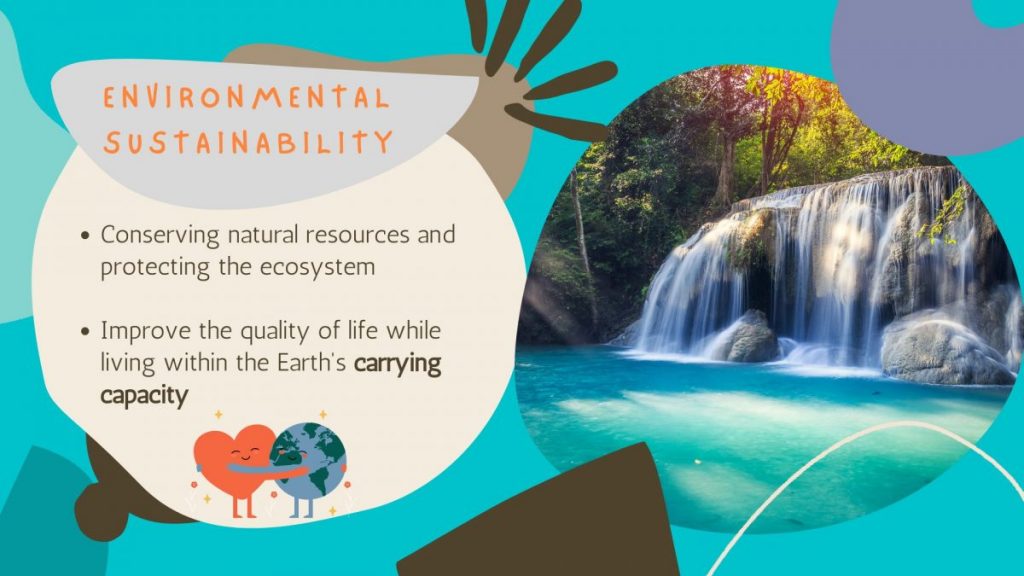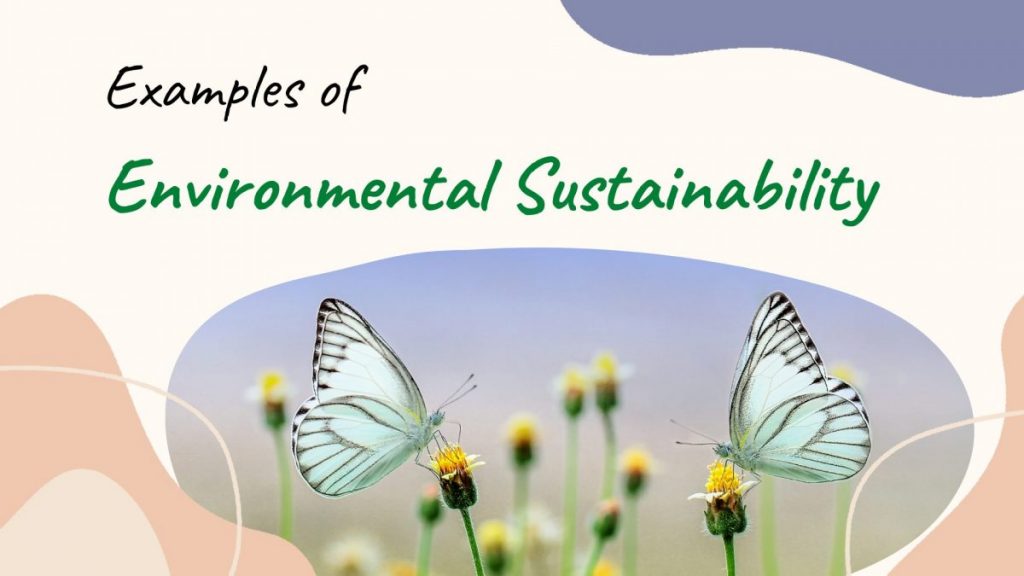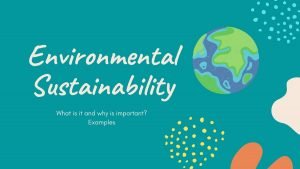What is the environmental sustainability definition? What are the main ecological issues? Why are those important?
Environmental sustainability is defined as the commitment to conserving natural resources and protecting the universal ecosystem supporting human life, now and in the future.
Key Takeaways
- Aims to preserve natural resources and protect ecosystems for future generations.
- Sustainable practices include agriculture, forestry, construction, waste management, water management, and renewable energy use.
- It’s essential for maintaining ecological balance, supporting economic growth, and ensuring social well-being.
Our wellbeing is closely associated with the health of the environment. According to the World Health Organization, 24% of deaths worldwide are linked to avoidable environmental factors. We need clean air to breathe, clean water to drink, and toxin-free places to live.

As we experience the long-term impact of significant industrial growth and energy use, we must be committed to reducing these effects and preventing further damage, ensuring we live in a healthy place for future generations.
For businesses, it means adhering to sustainable business practices and being committed to environmentally sustainable activities to build sturdy communities. This enhances future growth and potential. And that’s where the concept of environmental sustainability comes in.
Environmental sustainability has an impact on welfare & human wants, health, education, clean air & water and the safety of natural beauty. There is no doubt that the long term potential of our well-being depends on the proper utilization of the natural resources in the current generation.
What is environmental sustainability?

Environmental sustainability can be defined as the ability to improve the quality of human life while living within the carrying capacity of the global ecosystem.
Often the effects of many actions that are adversely influencing the environment are not experienced immediately, so one of the objectives of environmental conservation is to support the ecosystems by actively managing them: planting trees, preserving wildlife etc.
The environment, together with economic and social aspects are also known as the three pillars of sustainability (also known as the 3 principles of sustainability or the three E’s, with a more complex model also existing and based on 4 pillars). Sustainable development can be achieved by properly balancing those 3 principles.
Facts about environmental sustainability

- More research and sustainability reporting are covering various aspects of the business’s environmental, social, and governance activities. This generally includes an analysis of costs and benefits in relation to the organization’s financial performance. In particular, in the financial world, the ESG metrics (Environmental, Social and Governance) are becoming more and more important to investors when deciding where to allocate their funds.
- A strong commitment to environmental conservation, in the long run, will also lead to strong financial performance. This includes efforts towards the reduction of the corporation’s carbon footprint, reduction of waste and overall natural resources required by the business to operate. Those efforts will inevitably lead to a competitive advantage for the eco-conscious corporation.
- People began to realize that strategic efforts towards environmental sustainability will provide them with important business and social benefits. These strategies include prevention of pollution, eco-friendly product design, recycling, and much more.
- Governments are getting more and more sensible towards ecological issues and also becoming more active in implementing regulations supporting the environment. The United Kingdom will prohibit the selling of diesel-powered cars by the end of 2040. The UK took this decision back in 2017 to reduce air pollution in the environment. This will also reduce nitrogen dioxide levels below the E.U. limits within the shortest time possible to change the climate.
Suggested read:
Examples of environmental sustainability

Nature has a massive capacity to sustain and renew itself. Be it soil fertility maintenance or reforestation, when left alone, nature can renew itself to its original state. However, in some cases, this process may not be possible because natural resources are depleted.
To ensure that the ecological balance is maintained, we must change how we utilize natural resources. We have to apply environmentally sustainable methods to ensure that the next generation can enjoy the natural resources like we are enjoying them.
As such, several measures have been taken toward environmental sustainability to reverse the negative human impact on the environment. The following are just a few examples:
Sustainable agriculture
Sustainable agriculture is an important area that combines plant and animal production practices. This enhances productivity and positively impacts the environment. It assimilates biological and ecological processes into agriculture, minimizing the reliance on non-renewable resources and unsustainable inorganic processes.
Crop rotation is the perfect way to maximize the crops’ productivity. It helps renew soil fertility. Plant and animal waste can be recycled and used as manure to improve the nitrogen content in the soil.
Water management is another important aspect that plays a massive role in sustainable agriculture. In many dry locations, adequate water resources may not be available. In such locations, water preservation and storage are enhanced. Drip irrigation is another perfect way to conserve water resources without any wastage.
On a smaller scale, growing your own food, like tomatoes and other vegetables can also improve sustainability, because you will have to buy less things from the store, where they may sell food coming from the other side of the world. If you decide to start a garden, watch out for the squirrels, because they can eat tomatoes and other vegetables!
Sustainable forestry
Forests are the key contributors to the global environment. They host wildlife, and secondly, they purify the air from harmful pollutants and prevent soil erosion. Forests are the major contributors to the health of the ecosystem.
However, harsh exploitation by human beings has led to deforestation across the world, affecting the environment significantly. Sustainable forestry practices provide a chance to conserve some natural resources in their original state. This is accomplished by re-planting the number of trees that have been cut down.
In a sustainable forest, seedlings are grown in greenhouses and later transferred to the forest. In about 10 years, the seedlings develop into young trees within the natural environment.
Thinning is done after every 5 years to support the continuous growth of the stronger trees. After 20 to 25 years, we can proceed with deforestation, then new seedlings are planted to replace the trees that have been cut down, and the process continues. This is the perfect way to sustain the forest environment and maintain its greenery.
Sustainable construction
Large amounts of energy are consumed yearly for domestic purposes globally, including heating, cooling, and lighting. This can be reduced significantly by ensuring that homes and commercial buildings are built with sustainable concrete, are energy efficient and use renewable energy sources.
In sustainable construction, a resource-efficient approach is applied throughout the building, starting the life cycle with the planning, construction method, operation, and maintenance.
The buildings are designed to be well insulated for maximum surface exposure to sunlight in cool climates, allowing natural lighting and warming.
Buildings are also designed to be well ventilated in warm climates for minimum heating and proper lighting. This lowers the costs of temperature control and saves a lot of lighting expenses.
The inclusion of the green spaces into the residential areas enhances the location’s aesthetics and provides a perfect outdoor location to enjoy.
Finally, it is also very important that cities are planned with sustainability as a goal by applying the principles of sustainable urban design.
Waste management
Waste management or zero-waste policies are also another important aspects of environmental sustainability, because, unfortunately, massive wastage is still produced daily in every country. The unmindful disposal of these wastes into water bodies negatively impacts the environment and our health. Additionally, sea creatures are also suffering due to this disposal.
Sustainable waste management begins with a good waste management plan and analyzing the life cycle of the product. The design and manufacturing process in sustainable waste management is designed to generate minimum waste. If it does generate some waste, then the disposal of things like packaging materials should not affect the environment (recycling or biodegradable) or have minimal impact.
Many industries have begun packing products in biodegradable materials or using only cardboard, minimizing the environmental impact.
Composting is a perfect way to handle organic waste that can be used as manure for gardening. Similarly, wastes like metal, plastic, most of construction waste, and nylon can be recycled rather than disposed of for incarnation.
One of the most considerable environmental threats is the massive daily production of plastic waste. It threatens both aquatic life and alters the soil’s fertility. It’s also not advisable to burn plastic waste due to the emission of harmful gases. Recycling materials can help the environment, however, regarding plastic, we should also act more upstream by reducing their use to the minimum. This is the perfect way to manage plastic waste..
Sustainable water management
The largest percentage of the earth is covered by water. But we only need drinking water, which is very rare. The continuous use and disposal of water have led to the depletion of this essential life necessity in many areas of the planet, raising concerns.
Various water purification methods such as countertop reverse osmosis systems, distillers, under-counter purification, and filtration system have been developed to purify water. However, sustainable water management methods are worth using to ensure the water supply is not depleted.
The best way to start is to install water-efficient showerheads and low-flow taps in our homes, ensuring that there is a reduced waste of water. Those types of devices can in fact reduce water consumption by up to 40%. Additionally, through this, we can use only the water we really need.
Commercial or residential complexes can also profit massively from water treatment plants that can help recycle water. Using water-efficient methods can help in reducing water wastage.
Finally, rainwater harvesting has also been introduced in many places as a method for conserving water.
Renewable energy resources
Energy is a key component of human technological development and it is also a crucial aspect. Fossil fuels are the main energy source used today, however, those are quickly depleting due to their high demand. Although they are very cost-effective, they also are examples of non renewable resources and are not sustainable.
Environmental sustainability is key in this sector, so it’s worth looking at alternative energy sources that will be sustainable in the long run and that may perform similarly to fossil fuels. The following are a few examples:
Wind energy
Utilizing wind energy is a perfect way to supplement the grid power without harming the environment. With a starting investment in developing a windmill, we can generate power free of charge for offices, homes, or institutions.
Wind farms have been deployed with good wind speed in many places. For example, the Gansu wind farm is one of the largest wind farms in the world. The farm is located in China, with a current capacity of over 8GW and a planned expansion of up to 20GW.
Solar energy
The sun can be utilized as an energy source thanks to various technologies. Solar energy is the most popular form of green energy that has become common across the world.
Photovoltaic systems can be deployed in areas that receive good sunlight throughout the day. The energy can be stored and used when needed.
The energy of the Sun has also been used for new technologies that can replace continuous demand for electricity and other thermal power sources that can be hazardous to the environment. Solar thermal energy systems can be set up and used for water heating, cooking, heating homes, and generating energy.
Apart from this, the idea has also led to experiments with solar-powered boats, electric cars, and even aeroplanes.
Geothermal energy
The earth’s core is extremely hot with a temperature of about 5000°C. This energy sometimes penetrates through the earth’s crust and heats underground water bodies, also known as hot springs.
Geothermal energy has been used for a long time by therapists for therapeutic baths. Additionally, it is often used also for heating and the production of clean energy.
Hydroelectric energy
This is another renewable source of energy that has significantly contributed to the production of clean electricity. The power is usually generated by setting up dams and reservoirs. However, as of late, hydroelectricity has been generated without the need to set up dams.
Biofuel
Here is another alternative source of power. A lot of research is ongoing to develop a more efficient form of biofuel. This energy source is effective and can be used commercially.
Although biofuel has already been introduced in the market, there is still a lot of work to do to evaluate its general impact. For example, mass use of biofuels would require a lot of agricultural lands to be switched from food to the production of biofuel yielding crops.
Environmental regulations
Environmental standards vary based on local economic and environmental conditions. Regulations are often at the federal level. For example, the U.S. Environmental Protection Agency (EPA) regulates everything, including air pollutants, refrigerants, and hazardous waste management.
The Environmental Protection Agency establishes standards for the quality of air, water, soil, wildlife, habitats, and carbon emission and applies these standards with monetary fines and legal actions.
Also, state and local governments may set more rigorous guidelines. For example, cities such as Madrid and Paris are currently setting limits on diesel-powered vehicles and other car models that are less fuel-efficient.
However, research shows that more extensive regulation or business commitments may be necessary to achieve environmental sustainability. According to a study featured in a Harvard Business Review, multinational industries may be reducing emissions where environmental regulations are more stringent but, on the other hand, emit more in countries with more tolerant guidelines.
Economic growth and environmental sustainability
Environmental responsibility is a key item on modern companies’ agenda to achieve sustainability in their business activities. However, these activities can’t go against business goals. When done right, environmental sustainability should align revenue with people and the planet.
We know that unrestrained consumption takes a massive toll on welfare. Our energy use tends to rise in tandem with the GDP (Gross Domestic Product), leading to environmental pollution and exhaustion of natural resources. However, this does not mean that businesses can’t be environmentally sustainable.
Renewable energy firms represent a source of new jobs. Using less energy and plastic in energy production represents an opportunity to maximize profit margins. The mindset of business leaders needs to focus on a long-term vision and consider all the effects using detailed corporate cost-benefit reports.
Achieving high environmental commitments is an investment in the future economy where business can flourish.
Environmental issues
The earth is facing several issues regarding the environment. The environmental issues we are facing today differ from those that humankind faced in the previous generations. So, here are the issues we need to address.
Climate change
Often considered the quickest environmental disaster we may experience by scientists and other experts. Climate change is one of the most well-known facts affecting the world.
Unfortunately, it’s becoming challenging to talk about the way forward on climate change, and, while being a widely accepted idea, many academics don’t agree with the more catastrophic predictions.
Overexploitation of Natural resources
One of the most common environmental issues the world is facing regards the overexploitation of natural resources. Virtually all economic activities are linked, and many environmental practitioners condemn the over-exploitation of various resources and the growing gap between the wealthy and the poor.
For example, using water by one community tends to threaten the existence of another community and may affect nature itself.
Handling this challenge needs forward-thinking strategies and considering the environmental impacts.
Waste production
Waste management is the basic point that many environmentalists discuss. Dramatic images of waterways full of refuse and massive floating patches of oceanic waste have proved the danger of disposed plastics.
Comparably, electronic wastes show both environmental danger and missed opportunity given the immanent value of computers, peripherals, cellular phones other electronic devices.
There is also a challenge of food waste. Consumers in the most developed countries often discard a huge amount of food.
The textile industry is also one of the greatest polluters. Fast fashion has been on the rise in recent years, generating large amounts of waste and consuming a lot of resources for the production of clothes that are lasting for only one year at best.
Water pollution
Earth is often referred to as “the blue planet” due to how it looks like from space thanks to its vast oceans of water. However, only 3% of it is drinking water, and frozen glaciers are keeping two-thirds of it.
Around 1.1 billion people in the world are lacking water, and a total of 2.1 billion suffer from water scarcity. Unfortunately, water pollution puts 3% of fresh water at risk.
Deforestation
According to reports from NASA, forest covers 1/3 of the earth’s space and plays a massive role in the environment. For example, forest:
- Eliminate carbon from the air.
- Prevents soil erosion.
- Prevents floods.
- Promotes biodiversity.
- Trees produce the oxygen we breathe.
Overfishing
Overfishing supports the human population globally, and it’s not directly and immediate harm to the world. However, continuous overfishing can lead to lasting harm. You might be asking yourself how. Well, overfishing can lead to a deficit development: fisheries can become economically unsustainable.
This sometimes occurs due to unintended catches. Apart from getting rid of harmful subsidies, establishing advanced fishing methods, fishing rights, and public education can sustain the fisheries at risk.
Ocean acidification
Few laypeople are aware that a third of carbon dioxide released on the earth is absorbed by the ocean. Even fewer are aware that high carbon emissions can affect water quality and the pH of the ocean itself. According to the national oceanic and atmospheric administration, ocean acidity has increased by 30% in the last 200 years.
Air pollution
Air pollution is defined as the particles in contaminated air that penetrate the lungs and cardiovascular system. This causes diseases such as stroke, heart complications, lung cancer, chronic obstructive pulmonary disease, and respiratory diseases.
Major air pollution contributors include industries, transportation, coal power plants, and household solid fuel usage. Like many environmental issues, air pollution does not affect every corner of the world at the same time.
implementation
Achieving environmental sustainability is not an impossible goal. All we need is to join hands as individuals and businesses. We can achieve it by protecting renewable resources by supporting revolving sustainable farming to grow what we eat and buy products from local farmers.
Please note that a growing number of people are considering a vegan diet to be more sustainable. That’s why many Americans are now looking for the vegan burgers that taste like beef instead of the classic burgers made with animal meat.
However, they may not be aware of veganism’s negative effects on the environment and that a flexitarian diet may actually be the greener option.
Additionally, we can support reforestation and other sustainable projects by purchasing carbon offsets. Also, we can use renewable sources of energy rather than using fossil fuels. Lastly, we can achieve environmental conservation by supporting clean air and water projects. This limits the pollution of the environment.
Making changes in how we live, adopting an eco-friendly lifestyle following the 6 Rs of sustainability, can significantly help us achieve sustainability. For example, you can switch off the lights when not needed, prevent unnecessary water flow, use eco-friendly resources rather than plastics, use the cruise control, and many more.
Additionally, we can use items such as furniture and clothing that have been manufactured from eco-friendly materials.
Planting many trees appears to be basic, but it’s another way to achieve environmental goals. Forestation reduces global warming. Lastly, we can create awareness about sustainable living and its importance in our environment.
Why is environmental sustainability important?
- Growth: energy, air, and water are essential for the proper growth of human beings. Growth won’t be possible without proper sustainability. And proper sustainability depends on the factors mentioned in this article.
- Environmental quality: proper growth and development of the next generation depend on a healthy environment, like non-hazardous natural resources and clean air. As such, it’s important to maintain environmental sustainability today to enjoy the benefits in the future.
- Health: healthcare and sustainability are linked since environmental quality influences public health. The main objective of sustainability is to help us utilize the resources we have sustainably.
Conclusions
We can’t afford to ignore the fact that the future depends on the care we need to take today to sustain the natural resources and develop a better world for the future generation. It is our responsibility to sustain the environment for the betterment of the current generation and the future generation.
Let’s do what it takes to enhance the proper utilization of our resources by pursuing environmental sustainability. Lastly, let’s join hands and focus on minimizing air pollution. This can only be achieved through protecting natural resources.
Learn more:


